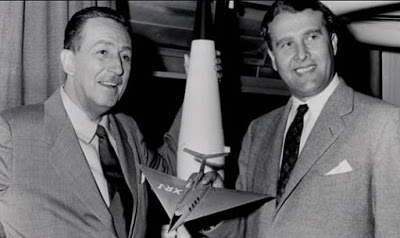
Walt Disney and Wernher Von Braun
Most Americans are aware of the German rocket engineer Wernher Von Braun’s association with NASA. Following is an excerpt from Wikipedia.
In his twenties and early thirties, Wernher von Braun worked in Germany’s rocket development program, where he helped design and develop the V-2 rocket at Peenemünde during World War II. Following the war, von Braun worked for the United States Army on an intermediate-range ballistic missile (IRBM) program before his group was assimilated into NASA. Under NASA, he served as director of the newly formed Marshall Space Flight Center and as the chief architect of the Saturn V launch vehicle, the superbooster that propelled the Apollo spacecraft to the Moon. According to NASA, he is, “without doubt, the greatest rocket scientist in history,” as well as the “Father of Rocket Science.” In 1975, he received the National Medal of Science. He continued insisting on the human mission to Mars throughout his life.
[Source: https://en.wikipedia.org/wiki/Wernher_von_Braun]
What makes a deception particularly effective is the merging of truth and lies. A deception based wholly on lies is implausible, and more difficult to sell to the public. NASA does employ rocket scientists, and they do send rockets beyond Earth’s atmosphere. NASA, however, has never sent men to the Moon, and Wernher Von Braun’s insistence that men can reach the planet Mars is only credible to those who believe man has already walked on the lunar surface. As we have observed, the Saturn V rocket, whose success is credited to Wernher Von Braun, was a work of deception. Its publicized capabilities were exaggerated. NASA did not possess a heavy lift rocket with the capability of sending 130 tons of equipment into lower earth orbit, and from there propelling men all the way to the Moon.
Before taking the oversight position of the Saturn V development program, Wernher Von Braun had declared that it would require a far more colossal rocket to reach the Moon. In the book Conquest of the Moon, published in 1953, Wernher Von Braun made the following comments.
It is commonly believed that man will fly directly from the earth to the moon, but to do this, we would require a vehicle of such gigantic proportions that it would prove an economic impossibility. It would have to develop sufficient speed to penetrate the atmosphere and overcome the earth’s gravity and, having traveled all the way to the moon, it must still have enough fuel to land safely and make the return trip to earth. Furthermore, in order to give the expedition a margin of safety, we would not use one ship alone, but a minimum of three… each rocket ship would be taller than New York’s Empire State Building and weigh about ten times the tonnage of the Queen Mary, or some 800,000 tons.
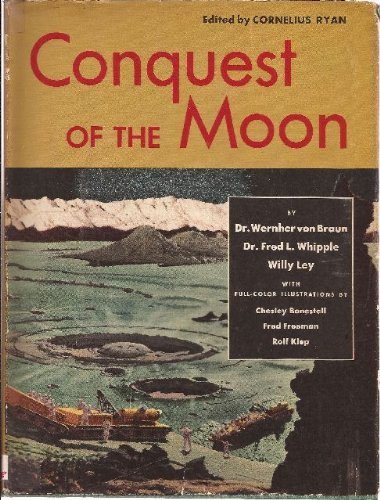
Front Cover
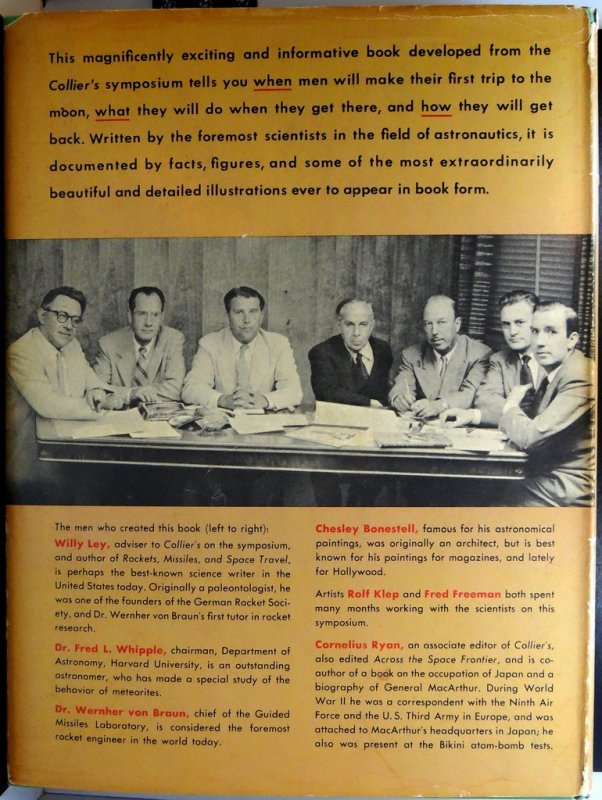
Back Cover
(Third from left on the back cover is Wernher Von Braun.)
Why did Von Braun state that it would require such a colossal rocket to send men to the Moon? At the time he made this statement, he had been studying mathematics, physics, and rocket design for 25 years. His comments in Conquest of the Moon represent the rational conclusions of a man who had spent decades designing rockets. Why did his estimation of what was required to land men on the Moon and return them to Earth alter so significantly after NASA hired him to salvage the Saturn V, a rocket which despite 5 years of development at Rocketdyne, the leading rocket builder in America, had not recorded a single successful launch by 1967? Were Von Braun’s remarks in this book a disclosure of the reality of rocket science at the time, while his work at NASA was more myth than reality?
NASA has built a mythological reputation around this German rocket scientist. This was out of necessity, for only “the greatest rocket scientist in history” could possibly have pulled off such an astounding feat as building a rocket capable of sending men to the Moon and back in the 1960s. Consider the extraordinary nature of the accomplishment attributed to Wernher Von Braun. On January 31, 1958, America sent its first rocket into space. This was the Explorer 1 Mission atop a Juno 1 rocket. The total weight lifted into space was 30 pounds (14 kilograms). By 1967 NASA’s most capable rocket, the Saturn 1B, could reportedly lift 46,000 pounds (23 tons) into low earth orbit. NASA would need a rocket capable of lifting 260,000 pounds (130 tons) into low earth orbit, and then boosting 90,000 pounds of that payload into a lunar trajectory to carry it an additional 240,000 miles to the Moon, and an equal number of miles on the return. How do you get from 23 tons in low earth orbit (approximately 120 miles) to 130 tons in low earth orbit, with the additional task of delivering the Apollo spacecraft all the way to the Moon and back (nearly half a million miles) in a little more than one year’s time? You call in Superman, Wernher Von Braun, and assign the task to him.
One goal of this book is to help Christians discern when they are being propagandized. When Satan and his human disciples intend to pull off an extraordinary deception, they begin by laying the groundwork for their illusion so it will not seem so incredible when it is revealed. Prior to the Apollo Space Program, magazines, science fiction books, television shows, and movies began regaling the public with stories of men exploring space via rockets. Werhner Von Braun’s book Conquest of the Moon was merely one of a great many media publications which began to seed into the thoughts of mankind the idea that men could reach beyond their own planet to the heavens beyond, extending their dominion over the creation.
Conquest of the Moon arose from a series of lengthy articles in the very popular Collier’s magazine. Collier’s was the fourth most popular magazine in the 1940s and 1950s. It lagged behind only Life, Look, and The Saturday Evening Post. In 1952, Collier’s organized a symposium of the world’s leading experts in space exploration. Among them were Wernher von Braun, then technical director of the Army Ordinance Guided Missile Development Group; Fred L. Whipple, chairman of astronomy at Harvard University; Joseph Kaplan, professor of physics at UCLA; Heinz Haber, of the US. Air Force Department of Space Medicine; and Willy Ley, an authority on space travel and rocketry. The symposium published a series of articles which appeared in Collier’s beginning in March of 1952 and running through April 1954. These articles served as the source for three books, all of which were highly illustrated: Across the Space Frontier (1952), Conquest of the Moon (1953), and The Exploration of Mars (1956).

These books in turn spawned many additional publications.
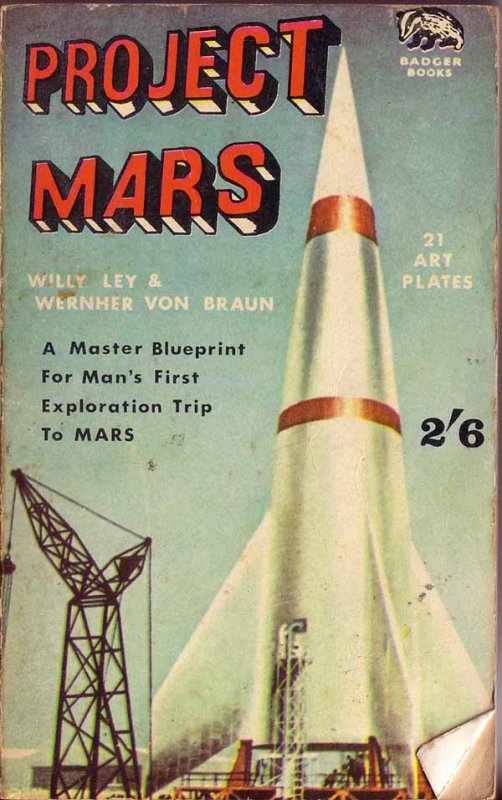
Project Mars by Willy Ley and Wernher Von Braun
From the 1950s onward, space flight became a popular subject in the media. Through a constant barrage of books and articles, movies and television shows, the public was being prepared to accept the idea of man being able to travel to other celestial bodies.

At the same time, Wernher Von Braun was being built up to mythological proportions. He was the German master of rocketry who would help America, and all of mankind, realize their dreams of reaching to the stars. Walt Disney, no stranger to creating world’s of fantasy, was called upon to help prepare the public to accept a future vision of manned space travel. Disney produced a number of special broadcasts on the subject of space exploration. Wernher Von Braun was further immortalized through these broadcasts, his reputation growing to astronomical proportions.
Man in Space – 1955
https://youtu.be/2fautyLuuvo
Trip Around the Moon – 1955
https://youtu.be/Zjs3nBfyIwM
Disney produced many more programs on the subject of Moon exploration and space travel. Isn’t it interesting that the company that made a global icon of a talking mouse would also play a key role in selling the idea of Moon exploration to mankind?
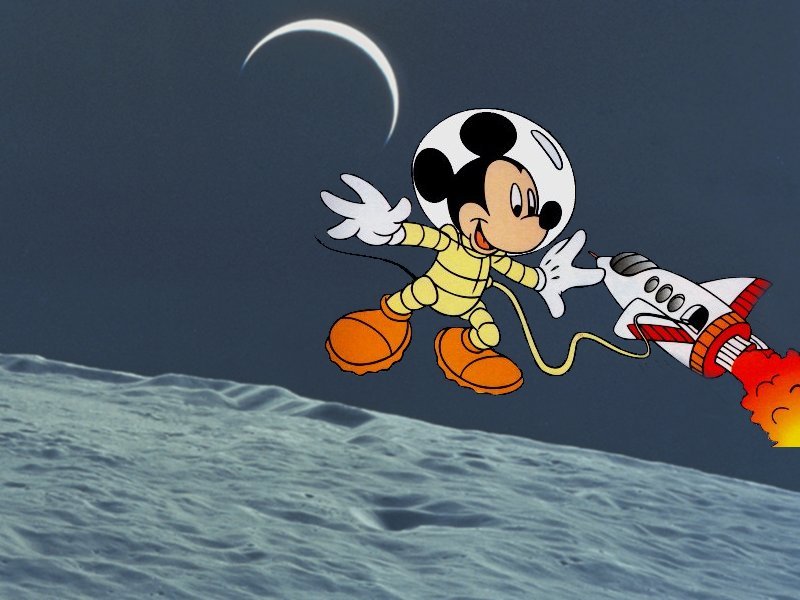
I do not doubt that Satan was mocking the folly of man by tying the two together. For those not yet aware, Walt Disney had deep associations with Freemasonry. Answering the question of whether Walt Disney was a Freemason, a website by Freemasons offers the following explanation.
Now part of what may have cause(sic) the confusion is that during the 1950s, Disneyland sponsored various clubs for its employees, including a knitting club, a shooting club, a skiing club, bowling and softball teams. There was also a Masonic club at Disney, presumably for the employees who were Freemasons.

However, even though Disney wasn’t a Freemason, he did belong to Demolay as a boy, which is a fraternal organization sponsored by Masonry. While many Demolay do go on to become Freemasons, Walt Disney never joined a Masonic Lodge. Walt Disney was kind of a big deal in Demolay–he was only the 107th member to join the organization, and a member of the Mother Chapter. He was later inducted into Demolay’s Legion of Honor, and the Hall of Fame. He was very fond of the Demolay organization, and spoke out favorably about it often. In fact, he made his creation, Mickey Mouse, a member of Demolay!
[Source: http://www.midnightfreemasons.org/2011/10/walt-disney-freemason-or-not_26.html]
DeMolay is a Masonic organization for children named in honor of Jacques De Molay, the last Grand Master of the Knights Templar, the paternal organization to which Freemasonry traces its roots. Jacques De Molay was burned at the stake in the year 1314, having been accused of numerous profane and obscene crimes. The Knight’s Templars were accused of many sordid acts, including worshiping Baphomet and indulging in homosexuality, pedophilia, and other forms of sexual debauchery. When one examines how the Walt Disney company perverts and sexually corrupts the lives of youth today, it is quite believable that the spirit of De Molay permeates this organization.
Others have speculated that Walt Disney was secretly a 33rd degree Freemason. This conclusion is supported by the secret club at Disneyland in California called Club 33.

Club 33 is a private club located in the heart of the New Orleans Square section of Disneyland. Originally maintained as a secret feature of the theme park, the entrance of the club was formerly located next to the Blue Bayou Restaurant at “33 Royal Street” with the entrance recognizable by an ornate address plate with the number 33 engraved on it.
[Source: https://en.wikipedia.org/wiki/Club_33]
Although I believe it was Stanley Kubrick who was given the job of directing the faked Apollo Moon landings, Walt Disney had an equally important role as he prepared the world to accept the fantasy of man traveling to other heavenly bodies to establish his dominion. Walt Disney, along with many others, did what Edward Bernays stated could be accomplished through the skilled use of propaganda. They succeeded in “puff(ing) up a nobody into a great man.” They built the myth of Wernher Von Braun to such an extent that people believed NASA when they said this German engineer had taken a failed rocket and turned it into the most capable rocket in human history.
Von Braun and crew would perfect in a few months “the biggest, most powerful, and most reliable rocket the world had ever seen – and has not seen since.” According to NASA, the Saturn V which had been consistently unstable in the hands of Rocketdyne’s engineers, would have all of its issues resolved in short order under the guidance of their German wunderkind. Not having achieved a single successful launch in the previous five years, it would prove flawless once NASA took control of the rocket’s development. The Saturn V would literally go from zero to hero. And with a perfect track record as the world’s mightiest and most reliable heavy lift rocket, NASA would promptly retire the Saturn V after the Apollo Moon missions, and then spend nearly ten years and billions of dollars developing an entirely new rocket system to be used with the Space Shuttle. The new rocket system would be less powerful, less reliable, and limit NASA to lifting payloads no greater than 50,000 pounds into space for the next forty years.
Only now, nearly fifty years later, does NASA have on the drawing board a new heavy lift rocket that will meet or exceed the capacity of the Saturn V. The Space Launch System (SLS) calls for a new rocket to be ready by 2018 which will be capable of lifting 70 tons into low earth orbit. That is little more than half of the Saturn V’s 130 ton capacity, but the SLS will be scaled up over time until it can lift 130 tons into space.
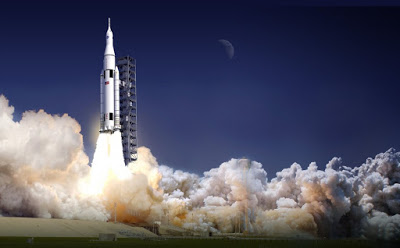
Artist’s Rendering of SLS with Orion Capsule
Why, with all the tremendous advances in computer processing, space age materials, and new rocket fuels, has it taken NASA 50 years to duplicate what they accomplished repeatedly with the Saturn V in the years 1968-1972? The obvious answer is that the Saturn V rocket did not in reality have the fabled capacity which NASA claims. This also would explain why the Saturn V was scuttled after the Moon missions and all its manufacturing components ordered destroyed by Congress.
If NASA intended to fake the Moon missions, they would not need a rocket with the advertised capacity of the Saturn V. The complete Apollo spacecraft was never seen by the public atop the Saturn V rocket. All the public saw was the outside of the protective cover. Assembly of the rocket and payload components occurred out of sight in a closed hangar, and was then rolled out fully assembled to the launch pad.
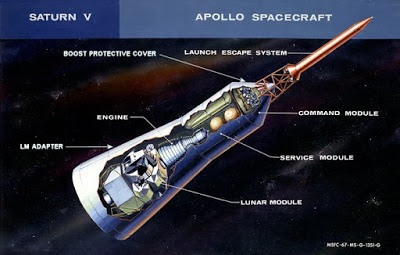
The only part of the Apollo Spacecraft visible to the public on network television as the rocket sat on the launch pad was the Command Module. This gum drop shaped module at the very top of the rocket is what the public saw the astronauts entering as they were strapped into their seats. Of the three modules, which also included the Service Module and the Lunar Module, the Command Module was the lightest of the three. It weighed only 11,000 pounds. NASA could easily have left the other modules out. They could have then used a far less powerful first stage for the Saturn V rocket than what would be required for an actual Moon mission.
Rocketdyne had met only with failure when attempting to combust the immense volume of fuel required for the five massive F1 engines of the Saturn V. For comparison, the Saturn 1B rocket used a cluster of 8 H1 engines, each of which provided 200,000 pounds of thrust. The Saturn V design called for a cluster of 5 F1 engines each of which provided 1,500,000 pounds of thrust. The vast volume of fuel which had to be combusted to provide this much thrust rendered the F1 unstable. The heat and vibration led to catastrophic failures.
Wernher Von Braun might have throttled down the rocket, improving its stability. It would be improbable that the public watching the launch could tell the difference between a rocket engine producing 500,000, or 750,000 pounds of thrust from one producing 1,500,000 pounds of thrust. With the weight removed from the top of the rocket, and the payload greatly reduced, this far less capable rocket could still make a good showing as it disappeared into the sky and out of the public’s sight.
Of the three modules, only the Command Module returned to Earth. The public would never see the Lunar Module or Service Module again. The base of the Lunar Module would be left on the Moon. The top portion of the Lunar Module would be discarded in lunar orbit, and the Service Module would be jettisoned to burn up in the Earth’s atmosphere just prior to the Command Module making re-entry. Consequently, there would be no way to examine these components to verify whether they had ever gone into space or to the Moon. The citizens of America and the world only saw these modules through the easily exploited medium of television.
NASA did not even need to send the astronauts into space. It is quite doubtful that if they had gone to the Moon that they could survive re-entry to the Earth’s atmosphere due to the intense heat generated. When satellites fall back to Earth, they inevitably burn up before they reach the ground. The Space Shuttle Columbia incinerated during re-entry when a single heat shield tile broke off. The intense heat of re-entry penetrated this vulnerable area, causing the hull to breach and the shuttle to disintegrate. The Apollo Command Modules would have experienced far greater temperatures than the Space Shuttles because of their greatly increased speed of reentry. The Apollo Command Modules would have hit the Earth’s upper atmosphere at a speed of 24,000 mph. The Space Shuttle’s reentry speed was about 17,500 mph.
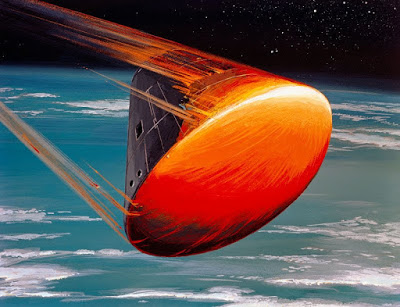
It is reported that the temperature of the Command Module on reentry reached 5,000 degrees Fahrenheit.
http://science.howstuffworks.com/apollo-spacecraft7.htm
The Space Shuttle, by contrast, heated to 3,000 degrees Fahrenheit.
https://en.wikipedia.org/wiki/Space_Shuttle_thermal_protection_system
In faking the Moon missions, NASA need only show the astronauts entering into the Command Module atop the Saturn V. Due to design changes mandated by the Apollo 1 disaster, the astronauts could open the hatch on the Command Module from the inside and exit freely. I find it quite plausible to believe this is what actually occurred. All of the Apollo Mission sequences would already have been filmed so they could be broadcast to the world as if they were a live mission. The Saturn V rocket’s ascent was never straight up. It always went into a low earth orbit before heading to the Moon. This is why viewers always observe the rocket arcing out over the ocean. NASA could have sent the rocket out of sight to some remote area of the South Atlantic and ditched it into the ocean. All they would need to do afterwards, is roll their pre-recorded film as if it was a live mission, and at the time for the mission’s end, they could drop an Apollo Command Module from a high flying cargo plane in the vicinity of the splash down area, and no one would be the wiser. Any terrestrial observers would see the Command Module floating serenely to the Earth as it was slowed by three immense parachutes.
If such a scenario sounds far-fetched, consider that NASA tested all of the Command Modules by dropping them out of the backs of airplanes. There is video available of them doing this with the Mercuy, Gemini, Apollo, and now the new Orion capsules.
Apollo Command Module Parachute Drop Test
https://youtu.be/QglyJDvZkew?t=5m10s
(Note: You can go to the 5:10 mark in the video to see the airplane portion of the drop test.)
Orion Command Module Parachute Drop Test
None of the Apollo Mission capsules upon their return from the Moon, were observed hurtling through sky prior to the moment their parachutes deployed, which was typically at an altitude of more than 20,000 feet for the drogue chutes, and 10,000 feet for their main chutes. Although the U.S. government had Navy vessels waiting to recover the Command Modules and astronauts, the splashdown into the ocean invariably occurred either at night, during cloudy weather, or miles away from the location of the rescue vessels. As if they were playing it safe, all three of the Apollo Missions which generated the greatest interest by the public, and received the maximum amount of television coverage, experienced reentry at night. Apollo 8, which was the first Mission to leave lower earth orbit and circle the Moon, Apollo 11 which was the first landing on the Moon, and Apollo 13, whose drama captivated the world, all experienced splashdown in the dark of night when it would have been impossible to observe the capsules being dropped out of the back of a high flying cargo airplane.
The world knows Wernher Von Braun as a rocket scientist. It is not as well known that he knew a few things about faking a rocket mission to the Moon. At the age of 19, Wernher Von Braun began working as an assistant to an older and more accomplished German rocket scientist, Hermann Oberth. Just two years prior to this association, Hermann Oberth served as a consultant to German film director Fritz Lang on his famous movie Frau im Mond (Woman in the Moon), released in 1929.

Oberth was employed by Fritz Lang to advise him on how to make a rocket mission to the moon appear realistic. Fritz Lang wanted to portray the steps required to get men to the Moon in a credible fashion. Space agencies from around the world have duplicated key aspects of Lang’s movie which add drama to the presentation of rocket launches. One such detail is the dramatic roll-out of the massive rocket to the launch pad followed by the countdown sequence.
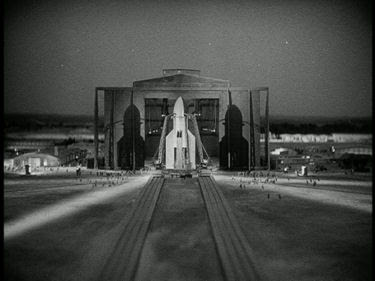
Fritz Lang Rocket Roll Out
America, ever the dramatic ones, have copied the example of rocket roll-outs first seen in Frau im Mond. They assemble everything in a closed hangar and then slowly roll out the vertical rocket to its launching pad.
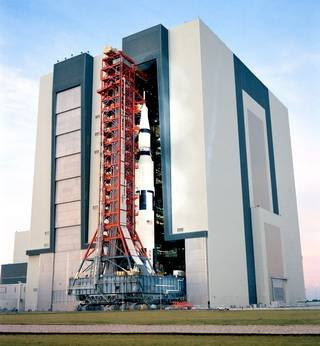
Roll Out of NASA’s Saturn V
The Russians have typically followed what they deem to be a more reasonable model. Moving a fully assembled rocket in an upright position where it is subject to high winds and instability is deemed an impractical approach to rocket launches by the Russians. Consequently, they roll their rockets out horizontally where they are far more stable and less subject to wind loads. The Russians only stand the rockets upright once they reach the launch pad.
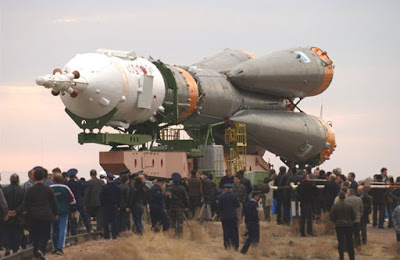
Roll Out of Russian R7 Rocket and Soyuz Capsule
Fritz Lang also popularized the dramatic feature of the launch countdown. This moment of high drama has been a centerpiece to every important launch in America. Wernher Von Braun learned from the best. What he could not make, he could fake.
America is renowned for its theatrical productions, whether they be Broadway, Hollywood, or NASA. The United States is the land of high drama. NASA has taken this drama to new heights. Millions of people from around the world flock to Florida annually to visit such attractions as Disneyworld, Universal Studios Theme Park, and the Space Coast encompassing Kennedy Space Center and Cape Canaveral Air Force Base. It is all a world of illusion, but it makes for great entertainment. The show must go on!
Heart4God Website: http://www.heart4god.ws
Parables Blog: www.parablesblog.blogspot.com
Mailing Address:
Joseph Herrin
P.O. Box 804
Montezuma, GA 31063


0 Comments